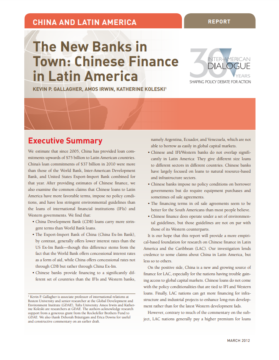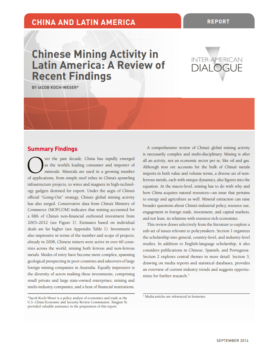
The New Banks in Town: Chinese Finance in Latin America
Estimates of the volume, composition, and characteristics of Chinese lending to the region since 2005.
On May 24, the Inter-American Dialogue and the Boston University Global Development Policy Center co-hosted a webinar titled “At a Crossroads: China’s Post-Pandemic Economic Relations with Latin America and the Caribbean.” The event considered China’s dynamic and evolving economic engagement with the Latin America and the Caribbean (LAC) region, and drew upon new findings and data recently published by the Inter-American Dialogue and the Boston University Global Development Policy Center. Margaret Myers, director of the Asia and Latin America program at the Inter-American Dialogue; Rebecca Ray, senior academic researcher at the Boston University Global Development Policy Center; and Ignacio Tornero, founder and CEO of East Consulting provided commentary. Fermín Koop, editor for Latin America (Southern Cone) at Diálogo Chino, moderated the panel discussion.
Ray opened the conversation with a discussion of the main findings from the Boston University Global Development Policy Center’s 2023 China-Latin America and the Caribbean Economic Bulletin. The bulletin identified three major themes that would play a significant role shaping China’s future engagement with the LAC region: diversification, maturation of the China-LAC relationship, and the placement of LAC goals at the forefront of the China-LAC relationship. In the case of diversification, Ray emphasized that “we are not seeing a switch [among LAC countries] towards a special relationship with China.” Instead, LAC governments are looking to establish strong trade relations with as many partner countries as possible, with China being one of these partners.
The China-LAC relationship is maturing in the sense that the deepening and development of supply chains in emerging industries are now focal points in the relationship, particularly in areas such as renewable energy, electric vehicles, and critical minerals. Ray also noted that LAC governments are attempting to emphasize their own existing priorities and goals, including social and environmental regulations, in their relationship with China, but Chinese firms have begun to push back against and dispute some investment-related decision-making in LAC, as seen recently in Ecuador.
Myers continued the discussion by citing findings from the Inter-American Dialogue and the Boston University Global Development Policy Center’s recent report, At a Crossroads: Chinese Development Finance to Latin America and the Caribbean, 2022, including highlighting the return of Chinese policy bank lending to the region last year in the form of three loans totaling just over US$800 million. Myers argued that while there has been a decline in Chinese lending and finance from its peak in 2010, totaling US$35 billion, “there are a lot of other important commercial banks and other financial institutions that are providing finance either directly to Chinese companies or sometimes to Latin American companies or even Latin American governments.” These new sources of finance include the New Development Bank (also commonly referred to as the “BRICS Bank”), the Asian Infrastructure Investment Bank (AIIB), and Chinese commercial banks, among other institutions. Moreover, China has demonstrated a continued and expanding interest in multi-tiered engagement and diplomacy with the LAC region, with a particular focus on the Caribbean where Chinese finance has primarily been directed to infrastructure-related projects.
Tornero provided in-depth analysis on the political, trade, and investment dimensions of Chile’s relationship with China, noting that the Sino-Chilean political and trade relationships have remained relatively stable even amid political shifts. With regard to Chile’s trade relations with China, the signing of a free trade agreement between the two countries in 2005 has led to a monumental increase in commercial engagement. In 2022, Chile’s bilateral trade with China totaled US$65.5 billion, accounting for 33 percent of the Andean country’s total trade. Moreover, bilateral trade between the two countries has grown at an annual average rate of 14 percent over the last five years. However, Tornero noted the need for LAC countries to diversify not only their trade partners, but the types of goods they are exporting. Currently, Chilean exports to China continue to consist mostly of primary commodities, such as copper. Chinese investment in Chile is still a relatively new phenomenon and remains concentrated in extractive sectors, though with recent activity evident in infrastructure, fisheries, and agribusiness.
The panel concluded with a Q&A session. Among other topics, participants discussed China’s willingness to participate in debt renegotiation talks with LAC countries, Chinese company support for LAC industrial upgrading, LAC environmental and social regulations and their role in shaping future China-LAC relations, and new sources of financing for LAC countries. Panelists also considered possible future trends in the China-LAC relationship.
Estimates of the volume, composition, and characteristics of Chinese lending to the region since 2005.
China has rapidly emerged as the world’s leading consumer and importer of minerals.
China’s rapid economic growth creates new possibilities for trade, investment and finance in the Caribbean.


